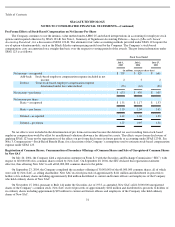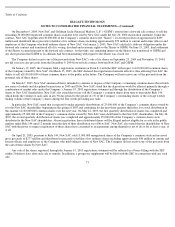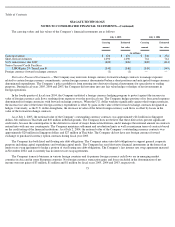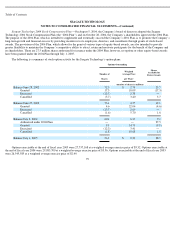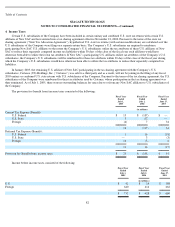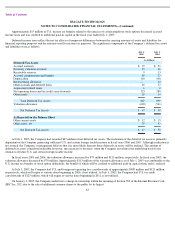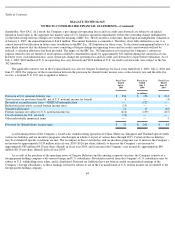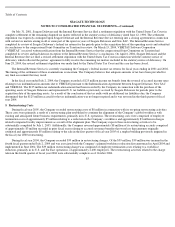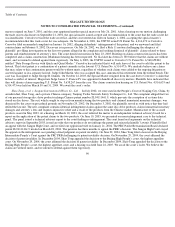Seagate 2004 Annual Report Download - page 85
Download and view the complete annual report
Please find page 85 of the 2004 Seagate annual report below. You can navigate through the pages in the report by either clicking on the pages listed below, or by using the keyword search tool below to find specific information within the annual report.
Table of Contents
SEAGATE TECHNOLOGY
NOTES TO CONSOLIDATED FINANCIAL STATEMENTS—(Continued)
For all employee stock options issued between December 11, 2002 and its fiscal quarter ended October 1, 2004, the Company estimated the fair
value of stock options issued to employees using the Black-Scholes valuation method with a volatility factor based on the stock volatilities of
its largest publicly traded competitors because the Company did not have a sufficient trading history. Beginning with its fiscal quarter ended
December 31, 2004, the Company’s volatility factor was estimated using its own trading history.
The weighted average fair value of the Company’s stock options granted to employees during fiscal years 2005, 2004 and 2003 was
estimated using the following assumptions:
Deferred Compensation Plan
2005
2004
Post-IPO
2003
Pre-IPO
2003
2001 Plan Shares
Expected life (in years)
3.0
–
3.5
3.0
3.0
3.0
Risk
-
free interest rate
2.9
–
3.6%
2.3
–
2.5%
2.1
–
3.0%
2.1
–
3.0%
Volatility
0.5
–
0.8
0.8
0.83
Minimum
Expected dividend
1.3
–
2.3%
0.5
–
2.0%
0.7
–
1.2%
—
Fair value
$6.55
$11.45
$4.80
$4.80
ESPP Shares
Expected life (in years)
0.5
–
1.0
0.5
–
1.0
0.5
–
1.0
—
Risk
-
free interest rate
1.6
–
2.2%
1.0
–
1.3%
1.2
–
1.3%
—
Volatility
0.3
–
0.6
0.5
–
1.0
0.7
–
0.9
—
Expected dividend
1.9
–
2.1%
0.8
–
1.5%
1.2%
—
Fair value
$3.86
$4.72
$3.31
—
On January 1, 2001, the Company adopted a deferred compensation plan for the benefit of eligible employees. This plan is designed to
permit certain discretionary employer contributions, in excess of the tax limits applicable to the 401(k) plan and to permit employee deferrals in
excess of certain tax limits. Company assets earmarked to pay benefits under the plan are held by a rabbi trust. The Company has adopted the
provisions of EITF No. 97-14, “Accounting for Deferred Compensation Arrangements Where Amounts Earned are Held in a Rabbi Trust and
Invested” (“EITF 97-14”). Under EITF 97-14, the assets and liabilities of a rabbi trust must be accounted for as if they are assets and liabilities
of the Company. In addition all earnings and expenses of the rabbi trust are recorded as other income or expense in the Company’s financial
statements. At July 1, 2005 and July 2, 2004, the deferred compensation amounts related to the rabbi trust were approximately $73 million and
$61 million, respectively, and are included in current liabilities on the accompanying balance sheets.
Post-Retirement Medical Plan
The Company’s post-retirement medical plan offers medical coverage to eligible U.S. retirees and their eligible dependents. Substantially
all U.S. employees became eligible for these benefits after 15 years of service and attaining age 60. The Company’s measurement date is
March 31
st
of each year.
In the fourth quarter of fiscal year 2004, the Company discontinued subsidizing its post-retirement medical plan for new retirees
subsequent to July 2, 2004. As a result, the benefit obligation accrued prior to July 2, 2004 for current company employees was eliminated and
the Company recorded a reduction in operating expenses of approximately $14 million in its first quarter of fiscal year 2005 related to this
reduction in benefit obligation. Other than the $14 million reduction in the accrued benefit obligation, the components of net periodic benefit
cost associated with the Company’s post-retirement medical plan for fiscal years 2005 and 2004 were not significant. The remaining benefit
obligation at July 1, 2005 is not significant.
81


